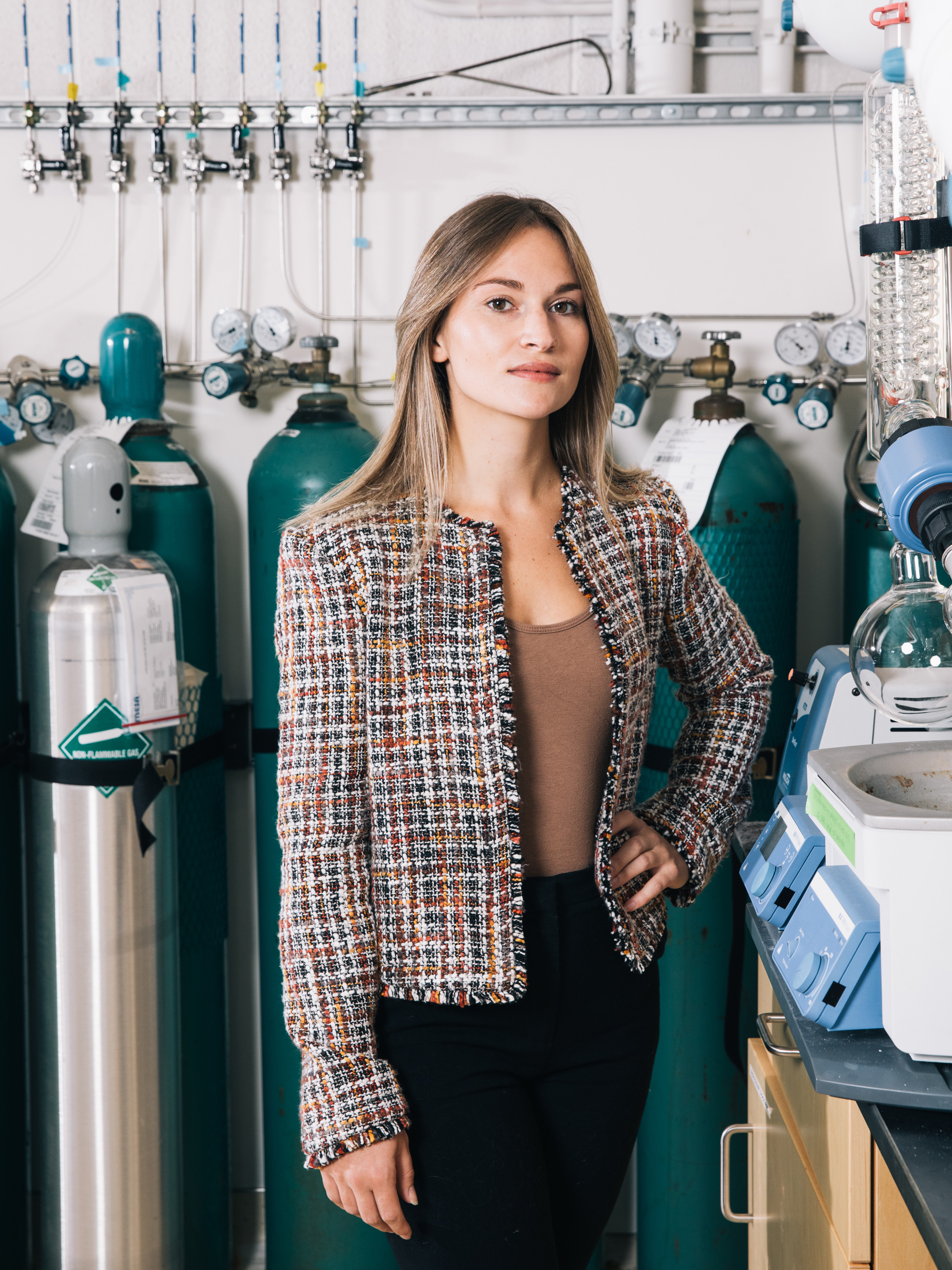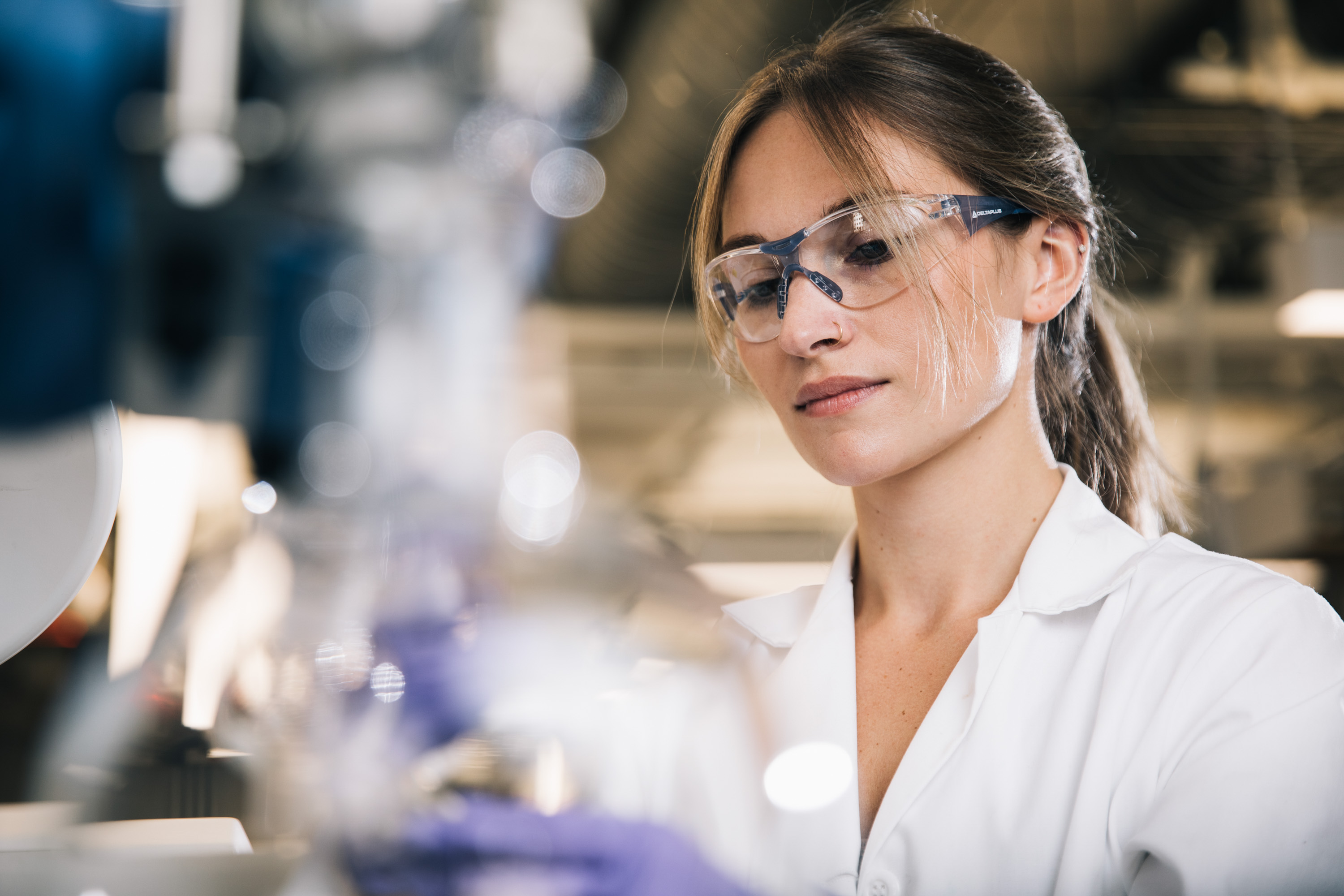The toxic chemicals all around us
As part of the MIT Superfund Research Program, Nicolette Bugher is working to expose the poisons lurking in our environment and discover what they mean for human health.

Nicolette Bugher has just given up on a failed experiment.
After she’d spent weeks designing it, and a few days running it, her materials now sit idle in a fume hood in the Parsons Laboratory for Environmental Science and Engineering, a visual reminder of the mistake.
Trial and error isn’t uncommon in science, of course, and Bugher shrugs it off. But she isn’t looking forward to the cleanup. That’s in part because Bugher, a PhD student in the lab of civil and environmental engineering professor Desiree Plata, PhD ’09, specializes in nasty substances that are hard to get rid of. Her research aims to identify the toxic contaminants all around us.
Industry constantly produces chemicals and invents new compounds, some of which “are harmful and toxic at very low levels,” says Bugher. “It’s important that we’re able to take an environmental sample and say, ‘What’s in this?’”
Bugher’s work is part of MIT’s Superfund Research Program (SRP), a collaborative project the Institute launched in 2017 to study the impact of carcinogens stemming from toxic sites. Under this program—one of about two dozen across the country—11 MIT professors and 18 trainees, including Bugher, collaborate on research in five project areas: water, air, systems biology, mutations, and genetic susceptibility. Plata serves as one of the project leaders—a logical extension of her group’s work analyzing the environmental impacts of industrial processes in hopes of encouraging companies to take sustainability into account.
Plata’s lab keeps the carcinogenic compounds it studies in a small fridge tucked under a lab bench, a cancerous minibar that Bugher uses to mix chemical cocktails she then compares with real-world samples. She’s looking for contaminants like n-nitrosodimethylamine, or NDMA, a manufacturing by-product and probable human carcinogen. The chemical has recently been detected in pharmaceuticals, such as the heartburn drug Zantac, and it can also form in drinking water systems as a by-product of municipal water treatment.
Bugher’s failed experiment was intended to determine whether the plastic and glass vials she uses for her work contain chemicals that can react to form NDMA, which could contaminate her samples and skew the results of future tests. She’s since redesigned the experiment and plans to run the modified version by sometime this winter. This is just a small part of her overall research, which zeroes in on techniques to detect contaminants in tap water.
When she was an undergraduate, Bugher says, a career involving long hours at a lab bench running experiments that required knowledge of complicated analytical chemistry was “the worst thing I could have ever—like, ever—imagined.”
Before she went to college, Bugher wasn’t familiar with the contaminated locations known as Superfund sites, some of which are polluted with hazardous substances linked to cancers. The sites are designated and regulated by the US Environmental Protection Agency under a 1980 law that created a fund to clean up especially polluted locations. Bugher’s coursework in environmental engineering led her to discover that her childhood home in Newark, Delaware, was just two miles away from a Superfund site that had contaminated the groundwater. And her house was right down the road from the site of an old Chrysler plant that used lead and other hazardous compounds. That site was cleaned up after the University of Delaware bought it in 2009; it now houses a research building.
But Bugher’s concern for the environment originated much earlier. For as long as she can remember, her family has vacationed at a lakeside cabin in Ontario, Canada. The house has no running water or toilet; the family drinks filtered water from the lake and catches fish to eat. At some point, a boat carried zebra mussels, an invasive species, into the water, and she noticed that the murky lake of her childhood turned “crystal clear.” The mussels ate the algae and other nutrients that would have fed other species, and some fish populations suffered.
That experience led Bugher to major in energy and environmental policy at the University of Delaware. Then a conversation with a professor helped her realize she could enact more change by conducting science herself, so she switched to environmental engineering. Another mentor encouraged her to seek work as a summer researcher at MIT—a departure from the focus on civil infrastructure in Delaware’s program. Impressed by Plata’s work and her dynamism in talks found online, Bugher applied to intern at her environmental engineering and sustainability lab before her final year of college. That summer, she found herself in her first wet lab, organizing and analyzing groundwater samples shipped in from Ohio. It’s the same lab she works in today.
Bugher now recognizes that “Superfund sites are everywhere.” The US government’s current priority list catalogues more than 1,300 of them, and only 452 have been completely cleaned up. She has had to work at the skills required to assess the impact of this pollution. When she was an undergraduate, she says, a career involving long hours at a lab bench running experiments that required knowledge of complicated analytical chemistry was “the worst thing I could have ever—like, ever—imagined.” But her work in the lab and mentorship from Plata during her internship gave her confidence that she could handle it. That summer, she says, changed her worldview on what environmental engineering could be. Now she spends every day using the chemistry she once dreaded.
Plata, the Gilbert W. Winslow (1937) Career Development Professor in Civil Engineering and an associate professor of civil and environmental engineering, agrees that Bugher’s academic background wasn’t necessarily “ideal” when she first arrived as a summer researcher. But Bugher put in the effort to get up to speed. “Nikki will get to the root of the problem and do the work that it takes to learn what she needs to learn, and then apply that learning,” says Plata. “It’s really exceptional.” Last spring, Bugher earned a graduate research fellowship from the National Science Foundation.

Now in her third year in the Plata lab, Bugher spent many of her early days as a PhD student learning to work a gas chromatograph, a sometimes finicky device used with a detector to analyze the composition of a complex mixture, like contaminated water. Samples are vaporized and then, by measuring how quickly each element of the mixture moves through the chromatograph, researchers can tease out the different molecules’ chemical properties to identify them. She’s now learning to use the lab’s high-performance liquid chromatograph.
But neither machine can detect NDMA in minute quantities—and precise testing is important for Bugher’s research because NDMA can affect human health at extremely low levels. While the EPA has not set a limit for the substance, which it classifies as a likely human carcinogen, Massachusetts drinking water guidelines specify a maximum of 10 nanograms per liter, an amount Bugher says is comparable to “a grain of sand in an Olympic-sized swimming pool.” Traditional analytical equipment often can’t detect compounds at levels that low, particularly when a slurry of toxic chemicals makes “a mess of things” at a Superfund site, she says.
So Bugher is working on a method of extracting water samples in a way that concentrates them before she analyzes them. If successful, it will allow her to detect compounds like NDMA at lower levels so she can find even trace amounts in complex mixtures of contaminated water.
Less than 20 miles from the Plata lab, residents of Wilmington, Massachusetts, await the results of MIT’s research. From 1953 to 1986, a series of chemical manufacturers operated out of a 30-acre section of Wilmington and dumped contaminants in unlined pits. The EPA added the site to the Superfund list in 2006, but not before contaminants reached wells supplying some of the town’s drinking water. Tests detected NDMA in the groundwater.
A 2021 report from the Massachusetts Department of Public Health showed that children whose mothers were exposed to NDMA in Wilmington while pregnant were three times as likely to develop cancer as those born to women who were not exposed. In Cambridge, a team of MIT’s Superfund Research Program researchers, including Bugher, was already working through the concerns. But research definitively linking toxic contamination with cancer risk is relatively rare, and the state report on the Wilmington site confirmed the urgency of the researchers’ task.
Water analysis is a cornerstone of the SRP’s work, says biological engineering professor Bevin Engelward, who heads MIT’s SRP. Without the work of researchers like Plata and Bugher, the other chemists and engineers on the project wouldn’t know precisely what’s in the community’s water, much less understand its effects or how to deal with them.
Bugher’s research could have ramifications far beyond Wilmington, or even Massachusetts. NDMA and its class of compounds are what Plata calls “slippery molecules”—they favor an aqueous form and are hard to separate from water. Engelward estimates that at least 1% of the US water supply is contaminated with the compound, potentially placing many lives at risk.
For Bugher, 26, the health implications of her research have already hit close to home. In August 2021, she visited the doctor for abdominal pain and was rushed to the emergency room after an ultrasound showed that her appendix appeared ready to burst. Although it wasn’t appendicitis, her surgeon later removed the organ—and extracted a tumor along with it. Hers was an uncommon but “easy” tumor that could be handled with a routine surgery, and fortunately, it was benign. She was back in the lab three days later, but knowing how lucky she was that it wasn’t cancer changed her outlook.
“Cancer—it’s unplanned, it’s unexpected. You’re never prepared for it—you don’t know where it comes from,” she says. “The work that we do is really important, because we’re trying to help toxicologists figure out where cancer is coming from and how to solve it.”
Doing work that affects communities and their health has made Bugher appreciate the chemistry her work entails. “It turns out,” she says, “I actually like chemistry a lot.”
Keep Reading
Most Popular
Large language models can do jaw-dropping things. But nobody knows exactly why.
And that's a problem. Figuring it out is one of the biggest scientific puzzles of our time and a crucial step towards controlling more powerful future models.
How scientists traced a mysterious covid case back to six toilets
When wastewater surveillance turns into a hunt for a single infected individual, the ethics get tricky.
The problem with plug-in hybrids? Their drivers.
Plug-in hybrids are often sold as a transition to EVs, but new data from Europe shows we’re still underestimating the emissions they produce.
Stay connected
Get the latest updates from
MIT Technology Review
Discover special offers, top stories, upcoming events, and more.